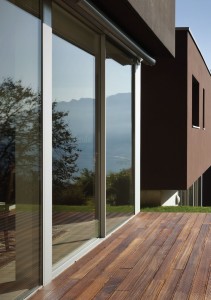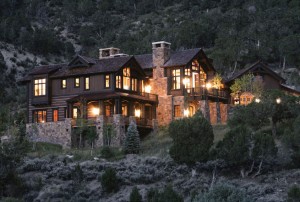 SITING
SITING
THE ART OF SITE ORIENTATION
by len ford
Finding the perfect spot and the perfect situation for a custom home in the West can be a tall task. In fact, siting should work hand-in-hand with the design of the overall home. A holistic design process starts with the place where the house and its occupants will live and considers all that the surroundings have to offer. Design first from the outside in and then focus on the interior and creating a floor plan that capitalizes on the optimal siting.
For all the right reasons, views always seem to be the first criteria for house orientation here in the Flathead Valley. Look around, it’s a no-brainer. But there are many other factors to consider.
VEGETATION
Trees and other natural vegetation are long-term assets that good site planning takes into account. Think seriously before removing trees unnecessarily; they grow slowly and provide ample benefits.
SLOPE
In the Mountain West, sloped sites are common, but the trick is making the slope work for you. Enough slope enables a daylight basement, controlling orientation substantially. Too little slope makes basement bedrooms less attractive, thereby potentially impacting overall building configuration. Establishing the floor elevations requires careful planning on sloped sites in order to economically design foundations, outdoor seating areas, and driveway approaches. There is always an elevation ‘sweet spot’ that, with enough forethought, reveals itself.
GRADING
A grading plan to manage stormwater is also key, especially near streams and lakes where runoff should be captured in below-grade infiltrators to protect open water from pollutants and silt. Stormwater should also surface-drain away from the building footprint so that it doesn’t invade the foundation. Most wet basements are saturated by roof runoff and/or improper grading, not by groundwater.
SUN
As the energy consumption of our homes becomes more concerning, orientation in relation to the sun is increasingly important. Even on a cloudy Flathead January day, the sun in the southern sky noticeably warms and brightens a well-insulated home with sufficient south-facing windows. Too often, home designs and orientations of the recent past ignored the energy that the sun offers, but we can change that. Earlier civilizations were much more in tune with solar benefits. In ancient Rome, it was actually illegal for your neighbor to block your home’s exposure to the winter sun. Our houses should invite the sun inside for the energy savings and to help stave off the winter blues.
On the flip side, the sun can work against a home’s comfort if too much glass faces east or west. In the summer, the sun early or late in the day can cause overheating, adding to either occupant discomfort or the cooling load for air conditioning.
WIND PATTERNS
House orientation that takes advantage of prevailing winds for ventilation can reduce cooling needs and suggest window arrangements.
GROUNDWATER
High groundwater on a building site can also dictate design. Why contemplate a basement if groundwater must be pumped from under the floor to keep it dry? If the water table is high enough, why even consider a crawlspace if an insulated shallow-footing slab foundation is more appropriate?
OUTDOOR LIVING
Patios, terraces, and firepit sitting areas help to make even modest-sized homes feel more spacious and also blur the line between outside and in, especially if some are roof-covered. These spaces also become the hubs for the landscaping and planting plans, further connecting the house to its site.
Like many things in life, every site has its own set of strengths, weaknesses, opportunities, and threats–with any luck, good site design accommodates them all. The act of marrying a home to Mother Earth may not be rocket science, but unhurried, thoughtful planning will go a long way toward making it a successful marriage. While it is possible to overpower nature in the short term, why not just work with it instead? We are creatures of the earth and, with a little respect, our homes can keep us connected happily with our little blue planet. Maybe even as contented as our napping dogs.
